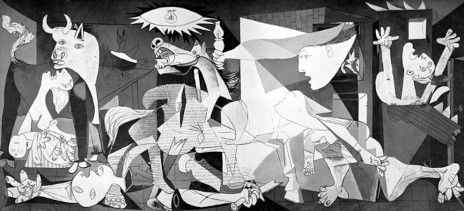Of Death and Awareness:
Picasso’s Vision of Life in Guernica
Habib Rezaei
The monumental painting Guernica by Pablo Picasso emerged in response to a critical situation in Spain. This work was a reaction to the bombing of a Spanish town by General Franco. Regardless of the reasons and circumstances surrounding this horrific event—which claimed the lives of nearly 1,850 people—what becomes significant is the Spanish painter’s reaction to the tragedy.
Guernica stands apart from many of Picasso’s other works. Its distinction lies primarily in the pervasive presence of death and awareness throughout the piece.
Picasso’s presence in France during its occupation by the Nazis did not bring about significant consequences of war in his personal life. Although he was painting at the Louvre during this time, the works he created were not related to the war or its aftermath.
The war to which Picasso responded was the Spanish Civil War. What became evident to the painter after this event was death—one of the four existential boundary situations.
Perhaps, for the first time, Picasso felt death close to him. Until then, he had often experienced love, another boundary situation.
Boundary situations refer to those conditions that can only be truly understood by going through them.
Picasso turned his attention to the massacre of his fellow civilians. From this emerged a work whose subject is death, suffering, and human pain.
Our understanding of boundary situations is highly complex. What Picasso knew of death was limited.
The bombing of civilians and their mass killing plunged Picasso into a deep void, resulting in a profound identification with the event. In such a state, he achieved a kind of understanding of a boundary situation—one that he could only convey by personally experiencing it.
What takes place in this work is, more than a report on the death of Spanish civilians, a report on the death of Picasso himself.
2010
Citation: ‘Adabiat-e Aqaliat’ ( in Eng: minority literature)
مرگ و آگاهی،
پیکاسو و انگارۀ زیستن در گئرنیکا
حبیب رضایی
تابلوِ عظیم گئرنیکا اثر مشهور پابلو پیکاسو در ارتباط با وضعیتی بحرانی در اسپانیا پدید آمد. این اثر واکنشی بود به بمباران یکی از شهرهای اسپانیا توسط ژنرال فرانکو. فارغ از علت و چون و چرایی این رخداد هولناک که نزدیک به ۱۸۵۰ نفر در آن جان باختند، آنچه در این میان اهمیت مییابد، نوع واکنش نقاش اسپانیایی به ماجراست.
گئرنیکا با بسیاری از آثار پیکاسو متفاوت است. این تفاوت به شکلی عمده در حضور فراگیر مرگ و آگاهی در این اثر خودنمایی میکند.
حضور پیکاسو در فرانسه در زمان اشغال آن توسط نازیها پیامد چندانی از جنگ با خود به همراه نداشت. هرچند در این زمان پیکاسو در لوور مشغول نقاشی است، اما آنچه خلق میشود به جنگ و پیامدهای آن مرتبط نیست.
جنگی که پیکاسو به آن واکنش نشان داد، جنگ داخلی اسپانیاست. آنچه پس از این رخداد برای نقاش آشکار میگردد، مرگ، یکی از وضعیتهای چهارگانۀ مرزی است.
پیکاسو شاید اول بار، حضور مرگ را در نزدیکی خود احساس میکند. او تا پیش از این، بارها، عشق، یکی دیگر از وضعیتهای مرزی را تجربه کرده است.
وضعیتهای مرزی به آن دسته موقعیتهایی اطلاق میگردد که برای درک آن بایستی در آن وضعیتها قرار گرفت.
پیکاسو به سراغ قتل عام غیرنظامیان هموطن خویش میرود. در این میان اثری به وجود میآید که موضوع آن مرگ، رنج و درد انسانی است.
درک ما از وضعیتهای مرزی بسیار پیچیده است. آنچه پیکاسو از مرگ میداند، اندک است.
رخداد بمباران غیرنظامیان و قتل عامل کثیری از آنها، پیکاسو را به درون حفرهای فرو میبرد که محصول آن همزادپنداری عمیق با این رویداد است. در این شرایط، او به نوعی به درک یک وضعیت مرزی نایل میشود. وضعیتی که پیکاسو برای ارائۀ گزارشی از آن، بایستی خود آن را تجربه کند.
آنچه در این اثر رخ داده است، بیش و پیش از گزارش مرگ غیرنظامیان اسپانیایی، گزارش مرگ پیکاسو است.



